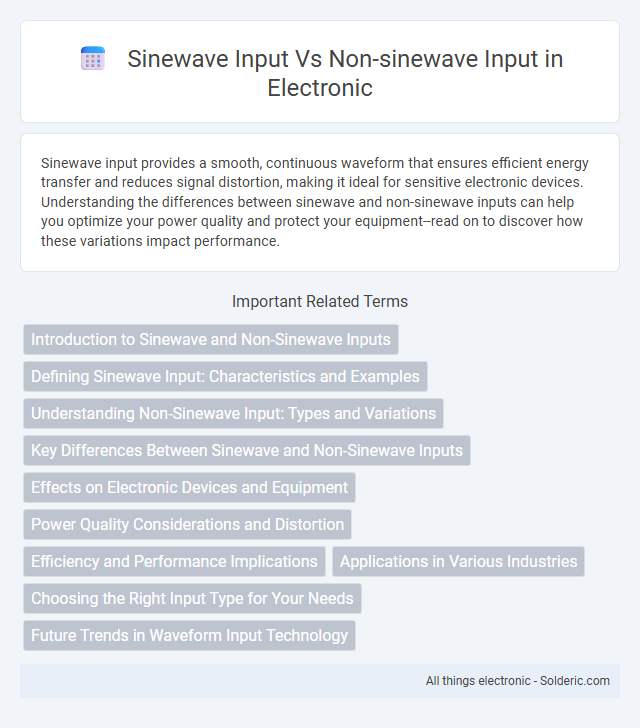Sinewave input provides a smooth, continuous waveform that ensures efficient energy transfer and reduces signal distortion, making it ideal for sensitive electronic devices. Understanding the differences between sinewave and non-sinewave inputs can help you optimize your power quality and protect your equipment--read on to discover how these variations impact performance.
Comparison Table
| Feature | Sinewave Input | Non-Sinewave Input |
|---|---|---|
| Waveform Quality | Pure, smooth, continuous wave | Distorted, contains harmonics and noise |
| Power Quality | High, stable voltage and frequency | Lower, prone to fluctuations and interference |
| Compatibility | Compatible with all electronic devices | May cause malfunctions in sensitive equipment |
| Efficiency | Higher energy efficiency and performance | Less efficient, potential energy loss |
| Harmonic Distortion | Minimal harmonic distortion (THD < 5%) | High harmonic distortion, impacting power systems |
| Heat Generation | Lower heat generation in devices | Increased heat, reducing device lifespan |
| Cost | Generally higher, due to better quality components | Lower initial cost, but potential long-term expenses |
Introduction to Sinewave and Non-Sinewave Inputs
Sinewave input refers to smooth, periodic oscillations that follow a pure sinusoidal pattern, essential in ensuring stable and efficient performance in electrical and electronic systems. Non-sinewave input, on the other hand, includes distortions such as harmonics, spikes, and irregular waveforms that can cause inefficiencies and potential damage to sensitive equipment. Understanding the differences between sinewave and non-sinewave inputs is crucial for optimizing Your devices' power quality and longevity.
Defining Sinewave Input: Characteristics and Examples
Sinewave input refers to a smooth, periodic oscillation characterized by a single frequency and amplitude, typically represented by a pure sine wave signal in electrical systems. This type of input produces a consistent and stable waveform with minimal harmonic distortion, commonly found in utility power supplies and signal generators. Understanding the purity of sinewave input is crucial for your devices, as it ensures optimal performance and protects sensitive electronics from potential damage caused by irregular waveforms.
Understanding Non-Sinewave Input: Types and Variations
Non-sinewave input refers to electrical signals that deviate from the pure sinusoidal waveform typical of standard AC power, including square waves, triangular waves, and distorted waveforms with harmonics. These variations can arise from electronic devices like inverters, rectifiers, or switching power supplies, causing issues such as increased heat, noise, or equipment malfunction if your system is not designed to handle them. Understanding the types and effects of non-sinewave inputs is crucial for selecting compatible appliances and ensuring optimal performance and longevity.
Key Differences Between Sinewave and Non-Sinewave Inputs
Sinewave input provides a smooth, continuous waveform that closely mimics natural AC power, ensuring efficient operation and longevity of sensitive electronic devices. Non-sinewave inputs, such as square or modified sine waves, feature abrupt voltage changes that can cause overheating, noise, and reduced performance in equipment. Understanding these key differences helps you select the appropriate power source that matches your device requirements and preserves optimal functionality.
Effects on Electronic Devices and Equipment
Sinewave input provides a pure, smooth waveform that minimizes harmonic distortion, ensuring optimal performance and longevity of electronic devices and sensitive equipment. Non-sinewave input, often characterized by distorted or modified waveforms such as square or modified sine waves, can introduce electrical noise, overheating, and reduced efficiency, potentially damaging devices with sensitive components like motors, transformers, and audio/video systems. Using sinewave input is critical for maintaining device stability, reducing electromagnetic interference, and preventing premature wear or malfunction.
Power Quality Considerations and Distortion
Sinewave input provides a consistent and smooth voltage waveform that minimizes harmonic distortion, ensuring high power quality and stable operation of electrical devices. Non-sinewave input, such as square or clipped waveforms, introduces significant harmonic distortion and electrical noise, which can degrade equipment performance and cause overheating or malfunction. Maintaining a pure sinewave input is critical for sensitive electronics and efficient energy use, reducing the risk of power quality issues and extending device lifespan.
Efficiency and Performance Implications
Sinewave input provides smoother power delivery and higher efficiency in electrical systems due to its consistent waveform, minimizing harmonic distortion and reducing stress on components. Non-sinewave input, such as square or modified sine waves, often leads to increased losses, overheating, and lower performance in sensitive electronics because of higher harmonic content and abrupt voltage changes. Devices designed for sinewave input typically achieve optimal performance and longevity, while those subjected to non-sinewave inputs may experience reduced efficiency and potential operational issues.
Applications in Various Industries
Sinewave input is essential in industries such as telecommunications, audio engineering, and power generation due to its smooth, predictable waveform that ensures efficient and low-distortion signal processing. Non-sinewave input, including square or triangular waves, is commonly used in digital electronics, switching power supplies, and signal modulation where rapid changes or distinct pulse shapes provide functional advantages. Your choice between sinewave and non-sinewave inputs directly impacts system performance, reliability, and compatibility across specific industrial applications.
Choosing the Right Input Type for Your Needs
Choosing the right input type involves understanding that sinewave input provides a smooth, continuous waveform ideal for sensitive electronics and precise signal processing. Non-sinewave input, often characterized by square or pulsed signals, suits applications requiring rapid switching or digital communication but may introduce harmonic distortion. Your selection should align with the tolerance of your equipment and the specific requirements of accuracy versus efficiency in your system.
Future Trends in Waveform Input Technology
Future trends in waveform input technology indicate a shift towards advanced non-sinewave inputs, such as modified sinewave and square waveforms, to enhance energy efficiency and compatibility with modern electronic devices. Innovations in digital signal processing enable more precise waveform shaping, reducing harmonic distortion and improving power quality in renewable energy and power conversion systems. You can expect increased adoption of intelligent waveform management systems that optimize device performance and extend equipment lifespan.
Sinewave input vs Non-sinewave input Infographic

 solderic.com
solderic.com